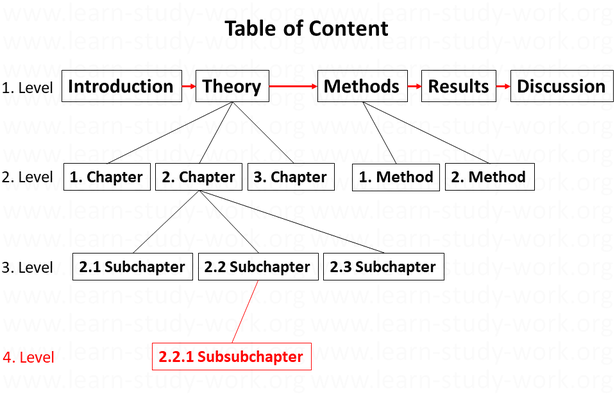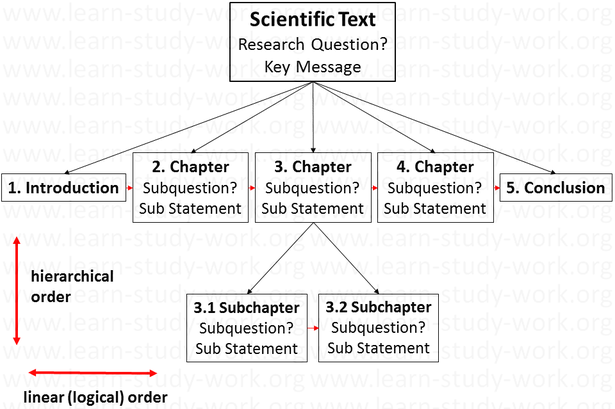How to structure a scientific text
Key message: The outline of a text must contain all important parts in a logical order and should make a good visual impression.
What is an outline?
An outline is the division of a whole into several parts. The structure of a whole is the arrangement of its parts. With a good structure, the parts fit together to give a well-recognizable whole.
A text structure is the "structuring of a text into subtexts ... how far a multiple subdivision on several hierarchically ordered levels is made, for large texts in chapters, paragraphs, sections, paragraphs" depends on the content structure and scope of the text. (https://web.archive.org/web/20081222153848/http://www-user.uni-bremen.de:80/~schoenke/tlgl/tlgl.html see text structuring,11.05.18)
Why are scientific publications always structured similarly according to their nature?
Scientists excel in their expertise and research areas. Researchers also need to read a large amount of scientific publications such as articles,
essays, books. If the scientific articles are structured uniformly, the reading is easy and can save a lot of time.
All scientific articles that present studies have the same structure: Introduction - Methods - Results and
Dicussion (IMRAD):
"The basic structure of a work is summarized under the abbreviation IMRAD.
Introduction (which question was asked?)
Methods (how was it examined?)
Results (What was found?)
And
Discussion (What do the results mean?) "
(Hall, G.M. et al.: How to Write a Paper, London, BMJ Publishing Group, 2003, 10/11/13)
IMRAD is not a formal but a principled structure. That means the chapters do not necessarily have to be "Introduction", "Methods", "Results".

So that a work does not become confusing, it should as far as possible be subdivided into not more than three levels. A chapter must be divided into at
least two subchapters. A chapter with only one subchapter is not allowed.
Which outline principle applies to all Bachelor's or Master's theses?
For all Bachelor's or Master's theses the outline principle applies: Introduction - main part - conclusion. So all works have an introduction, which usually means that. For the introduction,
therefore, the only question is: Should it be further subdivided or not?
A bachelor's or master's thesis is written for professionals. These know the structure of an introduction, which is why a subdivision is not absolutely necessary (it would take away space). If
the supervisor but want a subdivision z. For example, in motivation, task or structure of the work, then of course this desire to follow.
All work has a conclusion that corresponds to the discussion at IMRAD. However, the conclusion does not have the title "conclusion", but a different name (in an empirical work mostly
"discussion").
For the main part, all works (empirical as well as theoretical) apply at least one method and the results are presented and discussed. Empirical works are usually structured accordingly (IMRAD).
In theoretical work, at least one method is used in one or more chapters (analyze, interpret, argue, ...) and in these chapters the results are then presented and discussed.

In order to answer the research question, all work applies the basic principle of problem solving. Only those who have understood this can structure their Bachelor's or Master's thesis logically.
What is the basic principle of problem solving?
A problem exists when someone is dissatisfied with an actual situation and it is difficult to achieve the desired situation.
The desired situation can be achieved by applying a method. If you have scientific problems, you are dissatisfied with the known knowledge and would like to
come to new conclusions.
For a bachelor's or master's thesis, there is a desire to work out the results that can be used to answer the research question in order to achieve the goal of the work.
The following picture shows this connection:

The three main steps to solve the problem are (Lindemann, U. (2009) Methodological development of technical products, Heidelberg: Springer, p. 46,
20.06.13):
· Clarify problem and goal
· Generate alternative solutions
· Make decision (choose solution).
Clarifying the problem and the goal and generating solution alternatives is done on the basis of known knowledge. Then a solution, i. H. one or more methods selected and performed so that the
desired results are obtained (see "The Scientific Methods").
The research question and any other question / problem in the course of a bachelor's or master's thesis is therefore answered by this logical chain: putting together known knowledge - applying
methods - obtaining new results - answering a question / solving a problem.
To find the outline, this chain can be traversed backwards to answer the research question. For everything that follows the introduction serves the purpose of answering the research question at
the end of the work. The desired answer is therefore the starting point to find the necessary chapters to prepare this answer:
1. What results are needed to answer the research question?
2. What methods must be used to obtain these results?
3. What known knowledge must be put together so that the methods can be carried out?
How do I get to the draft outline?
The structure of a text is its division into several parts. The division depends on its content. If I know exactly what I want to write, I can structure
the text without any problem before I start writing. At the beginning, however, I usually only have a rough idea of its content. Luckily, I learned at school to organize a text before
writing:
"In the discussion we answer a question of fact which we view from different angles and penetrate in thought. ...
1. Collection of material: ... collect thoughts as they come up and write them down. ...
2. Material order and structure: The multiplicity of points of view must be arranged, tightened and summarized, ... Link so that the one fits in well with the other, whereby you either advance
from the general to the specific or from the individual to the general. " www.digitale-schule-bayern.de/dsdaten/587/724.pdf, 20.06.13)
The following describes how to move from the individual to the general to organize a text. (How to proceed from the general to the specific: see "Writing the text" under "Writing - 2nd
obstacle".)
1. Collection of materials
The aim of the collection of materials is to gain a comprehensive overview of the work, so that no outline point is forgotten.
I therefore take a piece of paper and write down all the questions, statements, aspects and points that come to mind about my work and the desired answer to the research question (main question).
At each point, I do a quick search on the Internet to see if my ideas are fitting and complete.
2. Order of substances and structure
"According to Kallmeyer / Meyer-Hermann, the attention in the text structure is directed to the" marking of boundaries ... "" Subtexts are segments that are relatively closed in terms of content and content ... "(http://www-user.uni-bremen.de/~schoenke /tlgl/tlgl.html see under text structure or subtext, 12.08.13)
The first thing in delimiting a text is to distinguish possible chapters and subchapters. So I have to look at the questions, statements, aspects and points found in the collection, and find those that I can summarize, so that a border to the other points becomes visible.
I arrange the summarized points in a hierarchical and linear (logical) order thus obtaining chapters and subchapters:

How do I arrange hierarchically?
"There is a hierarchical relationship between the text sections and the overall text, the thematic subordinates are subordinate to the overall text; in the subtexts subthemes of the entire text are developed, which contribute to the development of the main theme. "(http://www-user.uni-bremen.de/~schoenke/tlgl/tlgl.html see under text structure, 10.02.14)
Hierarchical means that there are parent and child outline points. The parent points exist only as headings. Only at the lowest level of detail is the text formulated.
If one knows which statements a text should make, it is possible to arrange the matching statements under headings. If the statements are not yet known, then it makes sense to go over a question in the outline of a structure. It is not about what statements a text should make, but what questions he should answer. The answers to the questions, ie the statements, can be found later.
In the case of a higher-ranking question, it is considered which sub-questions arise from it or which sub-questions must be answered in order to obtain a satisfactory answer to the overall question (see above).
In a second step, the questions must then be converted into headings, since it is not customary to divide scientific papers into questions. (I kept the questionnaire on STUWAP because it helps me to see if I have answered the questions completely.)
How do I arrange linearly (logically)?
A logical structure is a logical structure with a goal at the end. The parts of a text on the outline levels should be arranged (horizontally) so logically that the readers easily understand the goal statement of the text. Everything that is important for answering the research question must be present in the logical chain. Superfluous chain links must not occur.
What should the style of an outline be?
Stylistically, the outline must make a good impression. This refers to the subdivision in the text (in chapters, subchapters, paragraphs) and also to the table of contents, see the rules on http://bertbrechtgymnasium.de/intern/Horsthemke/regeln.htm, 12.08.13. (This text is outwardly poorly structured and therefore makes no visual impression.)
The structure must not be complicated or confusing. The main part (according to the structure principle: introduction - main part - conclusion) should consist of approximately 3 to 4 chapters for a bachelor or master thesis, if there are no special reasons to deviate from it.
What else needs to be considered?
It must be remembered that each scientific discipline divides its texts differently and even within a discipline there are different types of scientific work. Empirical, analyzing, interpreting or arguing works are not structured according to the same scheme.
Therefore, it makes sense to look at suitable finished works in order to get a feeling for the limbs in the respective subject area for the type in question. The adoption of a different structure is not allowed, but not possible, since there may be no other work that has answered exactly my research question.
Guidelines on the style of an outline (eg on the cover sheet, list of illustrations, bibliography, ...) can be found in the valid leaflet for writing a Bachelor's or Master's thesis. Since supervisors of bachelor or master theses often have personal preferences regarding the style, it would be best if I ask my supervisor if he can recommend me a stylistically exemplary work. Of course, I have to adapt the style used there to the particularities of my work.
Once I understand how scientific work is structured in my area of expertise, I am in a position to design a simple and consistent structure for my work. I discuss this design with my supervisor. If I write the text of my work and get new insights, I may have to change the design later.
